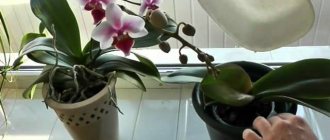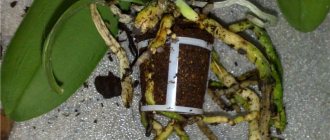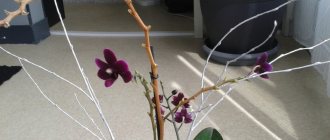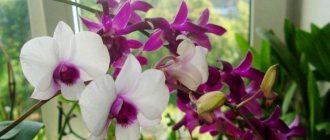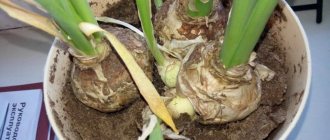Dendrobium nobile is one of the favorite varieties of many gardeners. The flower has large and beautiful flowers that are fragrant during their flowering period, spreading a pleasant aroma throughout the house.
The first time after purchase, usually no problems arise, the plant grows and develops, large buds are pleasing to the eye. However, sooner or later a moment comes when the dendrobium nobile orchid begins to fade and after a while not a single flower remains on the peduncle.
It is at this moment that novice gardeners literally begin to panic as to what to do next with the plant. And then you need proper care after flowering, which will lead to the fact that after a while the flower will again delight you with bright and beautiful buds.
Basic care issues after flowering
Caring for a Dendrobium orchid after flowering at home is required so that the plant can please us again with its beautiful blooms as soon as possible. On average, this species blooms from 8 to 12 weeks and is one of the most popular varieties of orchids. The main condition that must be met in any situation is the difference between day and night temperatures.
The Dendrobium orchid is very popular among amateur gardeners.
After the orchid has bloomed, the first thing to do is :
- Stop watering;
- Get rid of the old peduncle;
- Ensure a decrease in temperature, namely: move the flower to a cooler place . This way it can get ready to bloom again.
Experienced gardeners recommend not placing the plant in a dark place, as it may “hibernate,” which means stopping growth .
The Dendrobium orchid reproduces in two ways :
- Propagation by cuttings;
- And propagation by peduncle.
IMPORTANT! For sufficient lighting, especially in winter, experts recommend purchasing a phytolamp.
Do I need to apply fertilizer?
During periods of active flowering, fertilizers may not be applied. It is recommended to fertilize with a balanced complex after flowering at the beginning of the growth phase (summer time) and continue until autumn. For rapid development and full formation, use nitrogen fertilizers. In general, dendrobiums nobile are fairly unpretentious plants, well adapted to growing and breeding in the middle zone. By learning from this article what to do with such orchids after flowering and in each phase of the life cycle, you will ensure proper care and the possibility of re-blooming as quickly as possible.
If the Dedrobium nobile orchid has bloomed, you can find out what to do next in the video after reading the article:
How to determine if an orchid needs replanting?
The orchid has faded, what to do next? Do you need to understand whether the plant needs replanting? This can be determined by three key parameters :
- Soil condition;
- Condition of the ground part;
- Condition of the root system.
Most often, beginners encounter a problem when the flowering starts after purchasing an orchid in a store. If the plant is completely healthy and the soil has not yet decomposed, then there is no need to disturb the orchid.
Replanting a flower should be done only when the substrate begins to rot , thereby causing harm to the roots.
The average time for soil to decompose is 2-3 years. How to determine what condition the soil is in :
- Pieces of bark crumbled;
- The soil does not dry out after watering.
If the orchid has been living on your windowsill for about a year, after flowering you should definitely replant it . You should focus on the growth of pseudobulbs; as soon as they reach 10 cm in height, you can begin replanting.
The best time to replant an orchid is when new growth begins . In this case, the flower adapts much better to new conditions and new soil.
The condition of the root system is a rather serious signal ; if it does not have enough space in the old pot, you should immediately start replanting, because... this can lead to the death of the orchid.
Dendrobium orchid types and photographs
Currently, approximately 1,200 species of dendrobium are known. Natural species go on general sale much less often than hybrids created on their basis. They can be purchased at nurseries and botanical gardens, where they are used to breed new species. The following species are best suited for growing at home: Dendrobium nobilis, Dendrobium moniliforme, Dendrobium densely flowered, Dendrobium King, Dendrobium Parisha, Dendrobium phalaenopsis.
Dendrobium noble
Dendrobium nobile is one of the most popular and widespread species in cultivation; it has more than 80 varieties. The name of the species is derived from the word “nobile”, which means “famous, noble, noticeable”.
The Dendrobium nobilis orchid is a large epiphytic plant up to 90 cm high. Its stems are large, fleshy, swollen. The leaves are located on both sides of the stem and have an oblong elliptical shape. Short peduncles develop 3-4 flowers with a diameter of up to 10 cm. The flowers vary in color from white to dark purple. The lip is white with a large dark purple spot. It most often blooms from January to May.
Dendrobium moniliforme
Pictured is Dendrobium moniliforme
Dendrobium moniliforme is a Japanese endemic orchid that resembles Dendrobium nobilis, but is much smaller in size. The size of an adult plant is about 15 cm, and it begins to bloom when it reaches only 5–6 cm. The flowers are pink-white, fragrant. Blooms from late winter to early autumn.
Dendrobium dense-flowered
Dendrobium densiflorum is an epiphytic erect orchid. The tetrahedral stems thicken and have quite pronounced nodes, on top of which 3–4 leaves grow. The leaves are narrow, elliptical or lanceolate, rather fleshy and smooth. Dense inflorescences are collected in sagging racemes, which consist of a large number of flowers (from 50 to 100 pieces). The lip is pubescent, yellow-orange. The flowers are yellow-orange, their diameter is no more than 5 cm.
Dendrobium King
Dendrobium kingianum is a small epiphytic orchid. It has rigid cylindrical stems that thicken at the top. The leaves are located on the upper part of the stem in 3-4 pieces, lanceolate, up to 30 cm long and 3 cm wide. The flowers are small, collected in a raceme, and have a color from white to bright purple. The flowers are very fragrant, up to 2 cm in size. A special feature of this species is the curled tubular base of the lip around the column. Flowering begins in February and lasts for two weeks.
Dendrobium Parisha
Pictured is Dendrobium Parisha
Dendrobium parishii is an epiphytic deciduous orchid, reminiscent of Dendrobium nobilis. Its stems are thick, hanging, up to 40 cm long. The leaves are oblong, lanceolate, and have a small cut at the end. Inflorescences are few-flowered. The diameter of the flowers is up to 10 cm, color from pink to lilac. The lip of the flower is diamond-shaped or round, pink or white, decorated at the base with two dark purple spots. Blooms in spring or summer.
Dendrobium phalaenopsis
Dendrobium phalaenopsis is a large semi-deciduous orchid. The stems are long, erect, fleshy. They thicken towards the top and are up to 60 cm long. The leaves are lanceolate, long, and grow in the upper part of the stems. The peduncle reaches 60 cm in length. Large flowers, which are up to 9 cm in diameter, are colored in lilac-violet shades. It blooms from November to January, the flowering period is 5–6 weeks. At the moment, a large number of subspecies of Dendrobium phalaenopsis have been bred, which differ in the period and duration of flowering, as well as the color of the inflorescences.
When to do a planned transplant?
Experts consider the most favorable time for transplantation to be the beginning of growth .
Dendrobium orchids should be repotted when they begin to grow.
Before starting the procedure, you should stock up on fresh substrate , a new pot and tools for removing rotten parts of the root system, which must be disinfected.
After removing the faded orchid, you should carefully remove the old soil . To thoroughly clean the orchid roots, you should rinse them under warm water.
IMPORTANT ! Before transplanting, you should carefully examine the flower for the presence of parasites and diseases. Next, you need to dry the plant for 8-10 hours. The bottom of the new pot should also be treated with an antiseptic.
What to do with faded pseudobulb?
Pseudobulb is a storage organ that nourishes new shoots , providing favorable conditions for their growth.
Each false bulb blooms only once.
Experienced flower growers note that if only the upper part of the orchids has bloomed, under the right care conditions it is possible to ensure flowering on another part of the plant. It is not recommended to cut pseudobulbs; it can be harmful.
You need to wait not only for the end of flowering, but also for the moment when the leaves begin to fall and the false bulb begins to dry. Only in this case is it recommended to cut off the pseudobulb.
Brief characteristics of the plant
The flower belongs to epiphytes; under natural conditions it grows on trees and in cracks in the bark. The homeland of the species is the Himalayas. Translated from Greek it means “growing on a tree.” The height reaches an average of 50 cm, the leaves are dark green, oblong.
In the second year after planting, a large number of pseudobulbs can bloom, and the main peduncles remain at the top of the smooth pseudobulbs. With proper care, the entire trunk is covered with them. The flowers are large, up to 8-9 cm, purple, white, pink, yellow, purple. The inflorescences are quite short and contain 1-3 flowers of different tones, most often multi-colored. This tropical guest is not quite capricious, but you still need to follow some rules of care.
Necessary activities
Providing favorable conditions after flowering is the responsibility of every orchid owner. You should begin daily care after completing the following steps :
- First of all, you should cut off the peduncle ;
- It is not recommended to cut off the stem completely , because it is in this part of the plant that nutrients accumulate, which contribute to the further growth and flowering of the orchid;
- The resulting wounds should be carefully treat with mixture from charcoal and ground cinnamon. Many beginners skip this stage, but this can lead to the death of the plant.
After flowering, the orchid begins a period of rest.
In fact, immediately after flowering, the plant enters a dormant period . At this time, the flower does not need regular watering, but the optimal climate must be maintained in any case. You should also be careful when using various fertilizers.
IMPORTANT! Flower growers recommend using cling film to protect the soil from getting fertilizer. A spray bottle is perfect for fertilizing. It is recommended to use this procedure 2 times a month.
Dendrobium loves moisture , especially in the summer-spring period, as well as during the breeding season. The preferred watering method is submersion.
But this only applies to the hot season; during the dormant period, watering is recommended to be kept to a minimum . Water the plant only after the substrate has completely dried.
With proper care, the Dendrobium orchid will delight you with its blooms.
No matter how strange it may sound, during periods of active growth and flowering, experts recommend abandoning fertilizers .
The main periods when the plant needs feeding are the initial stages of growth and development. Continue feeding until cold weather sets in.
When choosing a fertilizer, preference should be given to fertilizers with a high nitrogen content during the period of active growth of the leaves and roots of the plant, and with a high content of phosphorus and potassium - before flowering .
Diseases and other problems
In some cases, dendrobium may lose its attractiveness and exhibit a number of symptoms that cause concern among gardeners.
Sometimes these “bells” are only part of the normal life process of an orchid, but they may also indicate the development of a disease in the plant.
Dendrobium leaves turn yellow
Yellowing and falling foliage of an apparently healthy flower is a natural process. Old leaves that have completed their life cycle fall off. The latter averages about 2 years.
Dendrobium withers
Shrinking of shoots during the formation of new pseudobulbs and during the dry period is also a common and normal process, so there is no need to panic too much.
How to save a dendrobium if it turns yellow and withers
pseudobulbs become flabby and wither
You can get rid of insects and help the orchid recover using laundry soap. The plant is thoroughly washed with it, and then treated with a 0.15% actellik solution.
Soap baths can also be used as a preventive measure.
Root rot
The reason is excessive watering. If the problem is not corrected in time, rot will spread from the roots to the stems, and the plant will begin to wither. Also, this problem can be caused by excessive use of mineral supplements. In both cases, in order to prevent the orchid from dying, it must be urgently transplanted.
The trunk of the dendrobium is rotting
Rotting occurs due to waterlogging of the substrate, or as a result of water getting between the leaves and the trunk. To prevent such a situation, after spraying, it is recommended to blot such places with a napkin, removing excess moisture.
If rot does affect the plant, it is necessary to urgently cut off all damaged areas, treat the wounds with charcoal or activated carbon, and spray the entire orchid with a fungicide solution.
Dendrobium is cracking
The formation of cracks on pseudobulbs is caused by:
- excess nitrogen fertilizers;
- a sharp temperature change that coincided with watering the flower;
- severe hypothermia;
- lack of moisture.
They also occur as a result of mechanical damage. If, in addition to cracks, the plant has no other problems, restoration procedures should be carried out.
These include the abandonment of nitrogen fertilizers (replace them with potassium-phosphorus additives), optimization of air temperature and irrigation regime.
Dendrobium sheds buds and flowers
This happens for several reasons. The most common: lack of fresh air or lighting, excessive or very frequent watering during the period of swelling of the buds. In order for an orchid to bloom, you need to slightly change its conditions by correcting errors in care.



